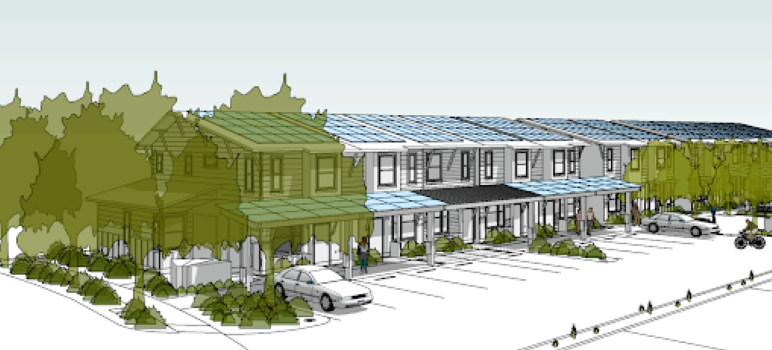The Santa Clara County Board of Supervisors signed off on $31.5 million for a trio of affordable housing projects on Tuesday, the latest steps toward meeting ambitious goals endorsed by voters nearly six years ago.
The projects will result in 36 housing units in San José (of which 14 are new for-sale townhomes) and 220 housing units in Milpitas. Funding for the projects includes $21.3 million from the $950 million Measure A Affordable Housing Bond approved by county voters in 2016.
Among the developments the board approved is Jackson Avenue Townhomes, the first affordable home ownership project to be funded under Measure A, which until now has supported multifamily rental housing.
The project, which will be developed by Habitat for Humanity East Bay/Silicon Valley, will include 14 townhomes with solar panels and electric vehicle charging stations.
The county's stated goal in 2016 was the creation of 4,800 affordable units to ease the region’s housing crunch, particularly for low-income residents, and reduce homelessness.
Five years into a 10-year plan to implement the 2016 Measure A Affordable Housing Bond, the county has committed $812.7 million to affordable housing projects. Once completed, this would account for 86% of the targeted 4,800 affordable housing units, but most of this money has not yet resulted in new housing.
Of the 44 housing projects the supervisors have approved, just 12 are in operation six years after voters approved Measure A, providing 1,186 housing units to 2,508 people, less than 25% of the county’s goal.
The Jackson Avenue Townhomes, according to the county, will provide home ownership opportunities to residents with a range of income levels. Of the 14 units:
- Five are for households that make up to 50% of the area median income (AMI)
- Seven are for households that make up to 80% of AMI
- Two are for households that make up to 120% of AMI
The county is contributing $4 million in Measure A funds to the project, which is also supported by $2.2 million from the City of San José, $1.2 million from the State of California’s CalHome program and $833,290 from Habitat for Humanity East Bay/Silicon Valley.
“Jackson Avenue Townhomes is the first project of its kind under Measure A,” said County Executive Jeffrey V. Smith. “We’re excited to provide residents who would otherwise struggle to afford a home the equity and sustainability of homeownership, and we will continue our efforts to ease the county’s housing affordability crisis.”
The other projects the board approved are the Mil on Main in Milpitas and the Pavilion Inn in San José, which will create a total of 242 affordable housing units.
The Mil on Main will include 22 rapid rehousing (RRH) units to help homeless working families and individuals regain permanent housing and 20 units for people with intellectual or developmental disabilities. It will also include:
- 11 units for households up to 30% of median income limits.
- 79 units for households up to 50% of media income.
- 85 units for households up to 60% of median income
- One manager’s unit
The Pavilion Inn will consist of 21 units of permanent supportive housing for transition age youth (ages of 18 and 25) with special needs, plus a manager’s unit, and 21 units of transitional housing for people in the same age range.
Consuelo Hernandez, Director of the County’s Office of Supportive Housing, said the board’s action is evidence of “the growing body of work the county is leading in closing the wealth gap.”
Hernandez’s office claimed that the county has made “significant progress on its goals for supportive housing,” which includes on-site services for the area’s most vulnerable residents.
“This funding is critical to getting shovels in the ground and building 14 affordable, sustainable homes on Jackson Avenue,” said Rob Simonds, Director of Housing Development for Habitat for Humanity East Bay/Silicon Valley. “In partnership with the county, Habitat will make homeownership possible for 14 families who have been priced out of the market.”


They also approved close to 50 thousand high end apartments and maybe more that sit at 45 percent vacant and higher for high tech workers. A studio rents for over 2500. There is close to 400 thousand vacant units like this across the bay area that sit vacant. If your building for the wealthy there is an abundance sitting vacant
Never mind the housing goals. That’s just a show.
The important thing here is that more government employees got paid more money and will receive bigger pensions.